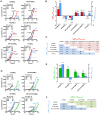Propagation of RML prions in mice expressing PrP devoid of GPI anchor leads to formation of a novel, stable prion strain
- PMID: 22685404
- PMCID: PMC3369955
- DOI: 10.1371/journal.ppat.1002746
Propagation of RML prions in mice expressing PrP devoid of GPI anchor leads to formation of a novel, stable prion strain
Abstract
PrP(C), a host protein which in prion-infected animals is converted to PrP(Sc), is linked to the cell membrane by a GPI anchor. Mice expressing PrP(C) without GPI anchor (tgGPI⁻ mice), are susceptible to prion infection but accumulate anchorless PrP(Sc) extra-, rather than intracellularly. We investigated whether tgGPI⁻ mice could faithfully propagate prion strains despite the deviant structure and location of anchorless PrP(Sc). We found that RML and ME7, but not 22L prions propagated in tgGPI⁻ brain developed novel cell tropisms, as determined by the Cell Panel Assay (CPA). Surprisingly, the levels of proteinase K-resistant PrP(Sc) (PrP(res)) in RML- or ME7-infected tgGPI⁻ brain were 25-50 times higher than in wild-type brain. When returned to wild-type brain, ME7 prions recovered their original properties, however RML prions had given rise to a novel prion strain, designated SFL, which remained unchanged even after three passages in wild-type mice. Because both RML PrP(Sc) and SFL PrP(Sc) are stably propagated in wild-type mice we propose that the two conformations are separated by a high activation energy barrier which is abrogated in tgGPI⁻ mice.
Conflict of interest statement
The authors have declared that no competing interests exist.
Figures





Similar articles
-
Prion Protein Devoid of the Octapeptide Repeat Region Delays Bovine Spongiform Encephalopathy Pathogenesis in Mice.J Virol. 2017 Dec 14;92(1):e01368-17. doi: 10.1128/JVI.01368-17. Print 2018 Jan 1. J Virol. 2017. PMID: 29046443 Free PMC article.
-
Strain-Dependent Prion Infection in Mice Expressing Prion Protein with Deletion of Central Residues 91-106.Int J Mol Sci. 2020 Oct 1;21(19):7260. doi: 10.3390/ijms21197260. Int J Mol Sci. 2020. PMID: 33019549 Free PMC article.
-
Prion seeding activities of mouse scrapie strains with divergent PrPSc protease sensitivities and amyloid plaque content using RT-QuIC and eQuIC.PLoS One. 2012;7(11):e48969. doi: 10.1371/journal.pone.0048969. Epub 2012 Nov 5. PLoS One. 2012. PMID: 23139828 Free PMC article.
-
Insights into Mechanisms of Transmission and Pathogenesis from Transgenic Mouse Models of Prion Diseases.Methods Mol Biol. 2017;1658:219-252. doi: 10.1007/978-1-4939-7244-9_16. Methods Mol Biol. 2017. PMID: 28861793 Free PMC article. Review.
-
The role of GPI-anchored PrP C in mediating the neurotoxic effect of scrapie prions in neurons.Curr Issues Mol Biol. 2010;12(2):119-27. Epub 2009 Sep 18. Curr Issues Mol Biol. 2010. PMID: 19767655 Review.
Cited by
-
Post-translational modifications in PrP expand the conformational diversity of prions in vivo.Sci Rep. 2017 Mar 8;7:43295. doi: 10.1038/srep43295. Sci Rep. 2017. PMID: 28272426 Free PMC article.
-
Preserving prion strain identity upon replication of prions in vitro using recombinant prion protein.Acta Neuropathol Commun. 2018 Sep 12;6(1):92. doi: 10.1186/s40478-018-0597-y. Acta Neuropathol Commun. 2018. PMID: 30208966 Free PMC article.
-
Cryo-EM structure of anchorless RML prion reveals variations in shared motifs between distinct strains.Nat Commun. 2022 Jul 13;13(1):4005. doi: 10.1038/s41467-022-30458-6. Nat Commun. 2022. PMID: 35831291 Free PMC article.
-
A Comparison of RML Prion Inactivation Efficiency by Heterogeneous and Homogeneous Photocatalysis.Pathogens. 2024 May 16;13(5):420. doi: 10.3390/pathogens13050420. Pathogens. 2024. PMID: 38787272 Free PMC article.
-
Acquisition of drug resistance and dependence by prions.PLoS Pathog. 2013 Feb;9(2):e1003158. doi: 10.1371/journal.ppat.1003158. Epub 2013 Feb 7. PLoS Pathog. 2013. PMID: 23408888 Free PMC article.
References
-
- Endo T, Groth D, Prusiner SB, Kobata A. Diversity of oligosaccharide structures linked to asparagines of the scrapie prion protein. Biochemistry. 1989;28:8380–8388. - PubMed
-
- Rudd PM, Wormald MR, Wing DR, Prusiner SB, Dwek RA. Prion glycoprotein: structure, dynamics, and roles for the sugars. Biochemistry. 2001;40:3759–3766. - PubMed
-
- Beringue V, Mallinson G, Kaisar M, Tayebi M, Sattar Z, et al. Regional heterogeneity of cellular prion protein isoforms in the mouse brain. Brain. 2003;126:2065–2073. - PubMed
-
- Somerville RA, Hamilton S, Fernie K. Transmissible spongiform encephalopathy strain, PrP genotype and brain region all affect the degree of glycosylation of PrPSc. J Gen Virol. 2005;86:241–246. - PubMed
Publication types
MeSH terms
Substances
Grants and funding
LinkOut - more resources
Full Text Sources
Research Materials

